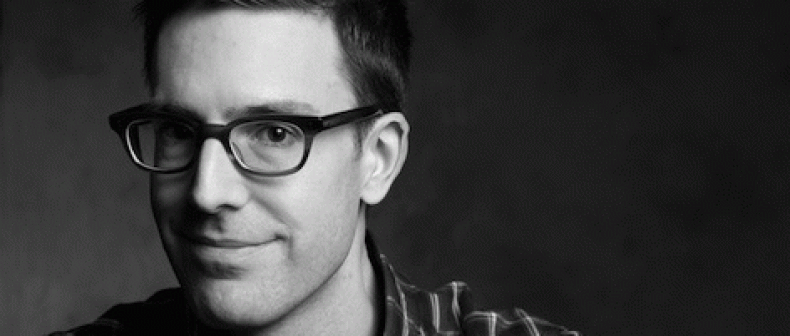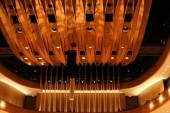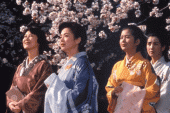
Sketch by Michael Gianfrancesco for The Midnight Court at Queen of Puddings Music Theatre
When I was a skinny little kid in sweat pants at Lord Lansdowne Public School, my friends and I used to put on musicals. Because I was the only boy, I often got plum roles, despite my lack of singing talent (especially after my voice dropped). I was the Mad Hatter in Alice in Wonderland, Matthew Cuthbert in Anne of Green Gables, Captain Hook in Peter Pan, and the Scarecrow in The Wizard of Oz. Like the ‘backyard musicals’ of Mickey Rooney and Judy Garland, we mounted our productions with no grown-up supervision. Unlike Mickey and Judy, we never made it to Broadway. (The school building itself, a round Modernist structure at Spadina and College, has had a better musical career than us–it was featured in the film Hairspray.)
Although now I only break out my musical prowess after the combination of a karaoke machine and alcoholic cider, speaking with costume and set designer Michael Gianfancesco about his early love of theatre made me wonder what path I could’ve ended up on if I stayed ‘in the business.’
Like me, Michael went to see all the big musicals like Crazy for You and Les Miserables when they came to Toronto with his parents. He also put on plays with his friends at school. Unlike me, he went to an arts high school where he majored in theatre, visual art, and music.
“We did two or three shows every year,” he says. “I sort of became more focused at the end of high school, because I loved visual art and I loved the theatre.” Designing sets and costumes was a great combination of his two passions.
That led him to the Design for the Theatre program at Concordia in Montreal, where he once again formed a production company with friends. The group did a lot of musicals and operas, in both Quebec and Ontario.
“When I came back from school,” he says, “I went out to work in New Brunswick, in Fredericton, to do this tiny little show. One of my teachers told me there was a designer who lived out there named Patrick Clark who worked a lot of the Stratford festival. I literally went and knocked on his door…He invited me in, and he eventually invited me to become his assistant at Stratford.”
Gianfrancesco says that working at the Stratford Festival was an incredible learning experience.
“It’s one of the biggest theatres in North America, the costume and set and prop departments are unbelievable. They work at the highest level, and they’re filled with people who make the most incredible things and are so highly skilled… I learned so much. It was like going to school for a second time, except for real.”
He appreciated working on both costume and set design.
“It came out of my visual art background, ’cause I did a lot of installation work, and so I always saw the environment and the people in it as one thing,” he explains. “I like the idea of being able to visualize the entire world, not just one narrow part of it.” A great example of how Gianfrancesco overlaps the two can be found in his designs for Stratford’s You’re a Good Man Charlie Brown (for which he did the sets, but not the costumes.) The stage was covered in yellow, and slashed with a giant black zigzagging line, a motif drawn from Charlie’s iconic shirt.
He points out that working in both fields is beneficial professionally. Some directors like working with only one person, “so that the ideas are all coming from one brain.”
Costume designers have to collaborate with practically everyone involved in the production, from the director early on to the actors, who often don’t see their costumes until right before rehearsals start. Gianfrancesco explains that for contemporary-set shows, rather than shop for specific items, he likes to acquire a handful of garments for each character, and then work with the actor to pick and chose their costume as though it was their own closet.
“I think then they feel more connected to who their character is and what they’re wearing as well.”
What was surprising to an unprofessional such as myself was the collaboration with the lighting designer.
“The lighting designer affects how everybody sees the show.”
(“Literally,” I couldn’t help myself from interjecting.)
“I know it sounds like a simple thing, but they tell you where to look. They control the focus. Colour-wise, depending on how the lights are gelled, they can really affect the costumes and how the set looks, because of how the colour hits something. If you’ve dressed everyone in this very subtle palette, and the lighting designer washes it out with bold colour–you have to communicate with them to make sure you’re on the same page.”
I’ve often wondered how costumes are different from everyday clothes.
“One thing is that you’re thinking about how does someone see this from faraway,” he explains. “So often, you’re pushing contrast and you’re pushing colour, you’re pushing the shape, in a slightly more exaggerated direction– especially in a larger theatre. They also have to last longer. If you’re working on a show at say Stratford or the Shaw Festival, somebody’s got to wear the costume for up to 90 performances. You know, they’re going to sweat in it, they’re going to be active in it, things have to be really well made.”
“All designers like to use real vintage clothes. Theatres hate that, because they’re so delicate. Often we use them as inspiration and we copy them. And then sometimes you’re in a small theatre, like Tarragon, and it is like doing a movie because the audience is four feet away from the actors. You have to adjust to your space.”
I ask him which productions he is particularly proud of.
Last year, he designed his first full-length ballet, an original piece for Les Grands Ballets Canadiens in Montreal based on the life of the sculptor Rodin. “We built the costumes from scratch for the company over the course of three months,” he says. Designing ballet costumes suitable for dancing while also evoking the 19th century proved tricky.
“It was a very bustle-y intense upholstered period. For dancers, it’s the antithesis of that. So you have to take the silhouette and then reinterpret it. We had a suggestion of bustles on the older characters because they didn’t dance as vigorously. Then we created bodices and skirts that created a suggestion of the shape, but kept it lighter.”
As can often happen when talking with me, all (yellow brick) roads lead back to Oz. I happened to catch Gianfrancesco’s production of The Wizard of Oz at the Young People’s Theatre in 2007.
“It’s a really, really important theatre, because it’s introducing kids to the performing arts,” he says. “It’s that doorway for them to discover it. Especially in a climate where culture in schools is diminishing.” Designing a show for children is “a blast” because everything can be big and broad. “When you design for kids, you push the envelope visually.”
I remembered how Gianfrancesco dressed Dorothy in denim overalls for her first scenes in Kansas, switching over to the famous gingham dress only when she arrives in Munchkin Land. My theory was that he wanted Dorothy to appear initially like a modern-day child rather than a country singer.
“That was something the director and I talked about doing, so that she had somewhere to grow as a character, and you saw where she came from. It allows the audience to relate to her at the beginning as a kid…It was really important to get the kids, who may or may not have ever seen the movie, to have a connection to her.”
But Gianfrancesco wanted to talk less about Dorothy, and more about the Wicked Witch of the West. In that production, she was played by the wonderful Toronto actor Sharron Matthews, known for her musical cabarets as well as delivering the immortal line in Mean Girls: “The girls have gone wild!”
“Our interpretation of that character was a little off. Usually, she’s in a black dress with a black hat and green makeup. We wanted to do something totally different.
Her hair was inspired by Diana Vreeland in a crazy, almost kabuki style. We gave her these huge glasses. And instead of making her green, her dress was green. It was made from 25 different kinds of fabrics.”
That dress was difficult for him to let go of at the end of the show, but he recognizes that it’s the actors and production that give costumes life. “When it’s hanging on a hanger, it’s just a piece of clothing, until somebody’s in it again. The person wearing it is what makes it exciting.”
Gianfrancesco is currently working on two productions at Tarragon Theatre (Little One and Other People’s Children) running simultaneously. This spring, he’ll be back creating costumes for Stratford and Shaw. In the mean time, he’s working with a small production company called Against the Grain on two art installations. He feels fortunate that his career has led him to work with interesting people in cities across the country.
“Each show is a new project and a new challenge,” he says. “Every time I start a show, I get to work with a whole new group of people. It keeps you going creatively. It’s completely collaborative. You can draw a pretty picture, but you’re only one piece of the big team.”
“It’s a cycle of highs and lows. As you’re getting toward the opening night, everything gets very intense. You get addicted to that kind of adrenaline rush. And then all of a sudden…my last day of work on a production is the opening night. Then it gets taken over by the theatre and it just runs, and we all go away.”
But, as we say in the theatre, there’s always another season.
___
Max Mosher writes about style for Toronto Standard. You can follow him on Twitter at @max_mosher_.
For more, follow us on Twitter @TorontoStandard or subscribe to our newsletter.














